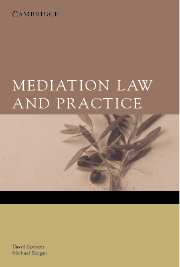Book contents
- Frontmatter
- Contents
- Acknowledgements
- Preface
- List of tables and figures
- Table of statutes
- Table of cases
- PART I THE PRACTICE OF MEDIATION
- 1 Mediation: Its Definition and History
- 2 The Mediation Process
- 3 The Theory and Philosophy of Mediation
- 4 Specific Types of Mediation
- 5 The Mediator
- 6 The Ethics of Mediation
- 7 Power, Empowerment and Difference in Mediation
- PART II THE LAW OF MEDIATION
- Bibliography
- Index
1 - Mediation: Its Definition and History
Published online by Cambridge University Press: 05 June 2012
- Frontmatter
- Contents
- Acknowledgements
- Preface
- List of tables and figures
- Table of statutes
- Table of cases
- PART I THE PRACTICE OF MEDIATION
- 1 Mediation: Its Definition and History
- 2 The Mediation Process
- 3 The Theory and Philosophy of Mediation
- 4 Specific Types of Mediation
- 5 The Mediator
- 6 The Ethics of Mediation
- 7 Power, Empowerment and Difference in Mediation
- PART II THE LAW OF MEDIATION
- Bibliography
- Index
Summary
Introduction
Mediation is a form of dispute resolution, found outside the adjudicative space of the court-room or tribunal, where parties in dispute or conflict utilise the assistance of a third-party neutral to attempt to resolve their dispute. It is different from other forms of ‘alternative’ dispute resolution – such as negotiation, conciliation, arbitration, and early-neutral evaluation – in that the third-party neutral, the mediator, is present and assigned a number of qualities that are not as evident, or strictly adhered to, in the other forms of dispute resolution.
Many commentators and adherents to traditional mediation practices maintain that a mediation is comprised of five distinct philosophies (confidentiality, voluntariness, empowerment, neutrality, and a unique solution), and that without these core components the mediation is impoverished, or not a true mediation. We explore these philosophies further in Chapter 3.
Why is mediation so important? Why do we use mediators and why do we mediate? Simply, many disputes cannot be resolved by the parties involved. This may be because of impasses to communication as a result of power or cultural differences between the parties. Impasses may also be due to historical factors such as a previous animosity and distrust between the parties or the absence of a relationship between the parties prior to the dispute arising. A mediator is someone who is able to assist the parties who are ‘stuck’ in their dialogue with each other to get together, communicate in a relatively polite and semi-structured way, and exchange information.
- Type
- Chapter
- Information
- Mediation Law and Practice , pp. 3 - 41Publisher: Cambridge University PressPrint publication year: 2007
- 1
- Cited by



